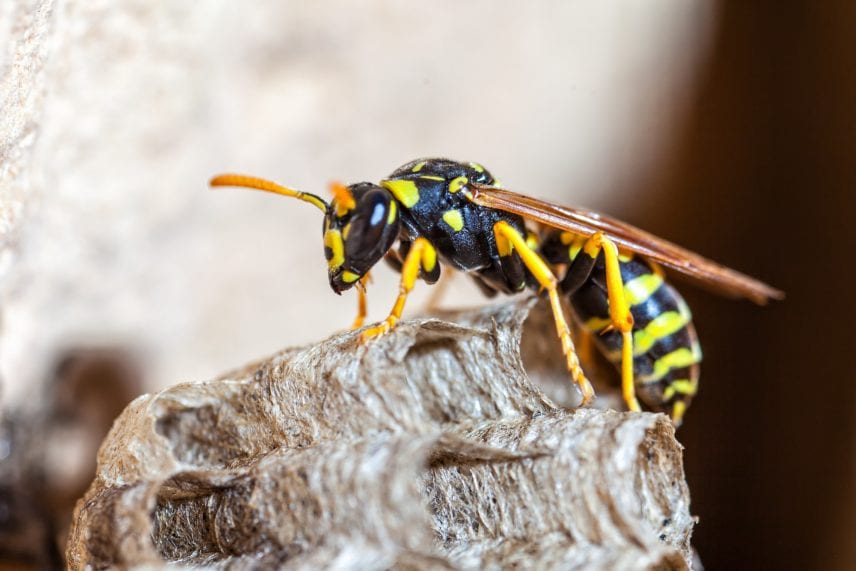There are over 4,000 species of bees that are native to the US, but what about wasps or hornets? While bees are relatively common, wasps and hornets can show up in or around American homes as well.
A sting by any of the three can be painful and swollen, but if you have an allergy, knowing which is which makes all the difference.
Do they come from the same insect family? How are they alike and why does it matter for your home?
If you’re trying to figure out what is different between a bee vs wasp vs hornet, check out our explanation below.
Bee vs Wasp vs Hornet: What’s the Difference?
Bees, wasps, and hornets are not the same insect even though they may seem that way to the untrained eye.
However, it is important to also note that within each of these categories, there are sub-categories of specific types. In other words, not all bees are the same just like not all wasps are the same.
Knowing if you’re looking at a hornet infestation or signs of wasps is one thing, but knowing the type of insect as well can be helpful to get rid of them entirely.
While these are general facts about how to spot these insects, doing some more specific research about the insects that are troubling your home could give you even more specific results.
What Does a Bee Look Like?
When most people think of a bee, they likely think of a honeybee or a bumblebee. There are many different types of bees that you may find in the United States, however, and they don’t all look the same.
Most bees that you will commonly see will be yellow, orange, black, and/or brown. You’ll also notice that bees typically are hairy and may have more of a circular body shape.
You can find most types of bees in hives or cavities, such as those within a tree, but you may also spot some on your flowers. Carpenter bees, however, like to live within exposed wood specifically.
Bees are unable to sting more than once, so it’s unlikely that they will do so if not provoked.
How to Spot a Wasp
The most common wasp in the United States is either the paper wasp or the yellow jacket, but both of these varieties look similar.
A wasp has a long body with a pinched waist. They are usually black with colored markings, such as yellow, white, or orange.
Depending on the type of wasp, some like to build their nests hanging off of eaves, branches, or fences. Others like to build nests inside the ground.
A wasp is a predator and they do like meat, so you can find them outside near food. They also like flowers and other foliage.
Wasps don’t lose their stingers when they are defending themselves, and they can sting you more than once. Don’t get too close to their nest if you can help it.
What Do Hornets Look Like?
A hornet is a type of wasp, but still in a separate category. This means that a hornet is a wasp, but not all wasps are hornets.
Hornets are more round than the average wasp you might see and they are usually seen with brown, red, or yellow markings on a black body.
Another big difference between wasp vs hornet is that a hornet is usually between 1 to 2 inches long.
Hornets are aggressive and their stings hurt more than a wasp or bee sting.
Like wasps, a hornet can sting repeatedly. If you are stung by a hornet, knowing how to treat the sting can be important to lower the pain level.
What Should You Do When You See One?
Whether you see a bee, wasp, or hornet, the best thing to do is steer clear.
If you see a flying insect approaching you and you think it might be one of these three, try to keep still. This will make it less likely that the bug will see you as a threat.
Don’t swat or flail your arms! This will aggravate it and you’re more likely to get stung. If you have to run away, try to keep your arms down and do so in a straight line away from the insect.
How to Avoid Bees, Wasps, and Hornets
If you’re seeing a lot of these insects flying about in your garden or near your yard, it’s likely that you may have a nest or hive nearby.
The best thing to do in this situation is stay indoors and contact a professional for some help getting rid of the insects.
To deter bees, wasps, and hornets from even wanting to come to your home, there are a few simple things you can do.
Don’t leave out any drinks or food. This will attract wasps and hornets to your home.
Plant some specific plants, such as those that repel bees or wasps, around your home.
Seal up any garbage cans you have outside and pick up all of the trash, especially if it is from food or drink products.
If you’re able to locate a nest before it becomes too large, it’s more manageable. This is why it is a good idea to check around your home for these and cover up any holes that may seem like a good home base for an insect.
Are You Dealing With an Infestation?
Now that you’ve got a better idea about the difference between a bee vs wasp vs hornet, you can handle a pest problem more easily!
Our team has the equipment and tools that are needed to keep you safe. If you feel like your pest control issue has gotten out of hand or you’d like a professional opinion, we are here to help you.
Are you looking for an environmentally-friendly pest control team? Contact us and let us know what we can do for you today.


